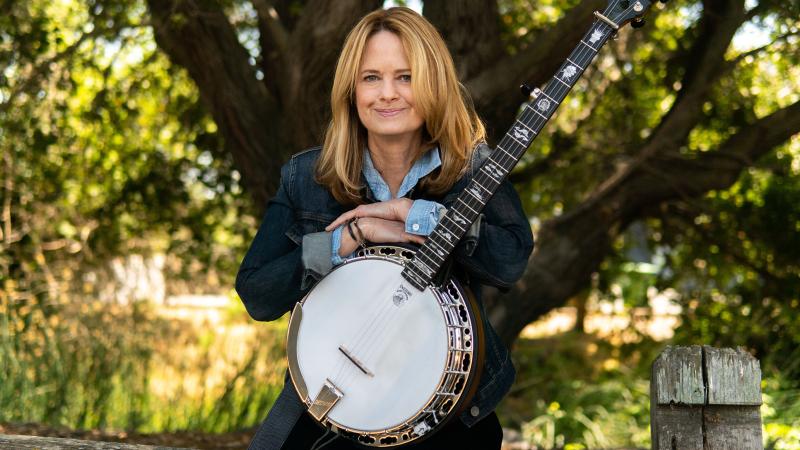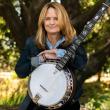The banjo, Alison Brown, and one fine band
Alison Brown and her Band are returning to the Opera House Friday, June 7 and no one, I repeat, no one should miss this concert. Sure, you may have seen her there before, but sometimes once really isn’t enough. Just sayin’.
I had the privilege of speaking with Alison last week about the gig, her lifelong love of the banjo (she was just 10 when she first started to play), Earl Scruggs, last year’s CD, “On Banjo,” the band, Steve Martin, kids and the Opera House at Boothbay Harbor.
Alison Brown started out learning guitar as a kid, but the day her teacher brought Flatt Scruggs’ “Foggy Mountain Banjo” album over to her house she knew that guitar was going to be replaced. Her dad made a cassette tape of the LP for her. “I loved the sound of the banjo so much my parents said if I practiced my guitar really hard for one year, I could take up the banjo the next summer.”
And Alison still had that first Mayfair banjo her folks got her that next summer until a few years back when she donated it to be raffled off for the San Diego Bluegrass folks.
Alison Brown may not name her banjos the way some famous musicians have, like Clapton’s “Brownie” and “Blackie” Stratocasters; Willie Nelson’s “Trigger,” or BB King’s “Lucille:” but she does collect banjos like others do guitars.
How many banjos does she own? Well, not that she can believe it, but her husband, and bass player of the band, Garry West, says he’s counted them … all the way up to 25. Here are Alison’s Top 4: An Earl Scruggs’ Vegas Solist banjo (and the Earl Scrugg’s model). “His son Gary told me his dad used to sit in front of the TV and play it all the time,” she said.
John Hartford’s prototype Deering Low – “It’s really cool,” said Alison, “I use it for some sessions, but always pick it up to write on cos it has John’s influence in it.”
An original 1938 Mastertone considered the Holy Grail of the five-string banjo because, noted Alison, “Earl Scruggs hadn’t made the five-string bluegrass style popular yet. They are kind of an anomaly.”
The fourth is one she tours with, this banjo was made by luthier Yarosif Priceau of the Czech Republic. “He’s an amazing luthier. There’s a lot of amazing banjo players there because they (the people) embraced bluegrass and folk music as a form of social protest under the Soviet occupation,” she said.
And, no doubt, Pete Seeger’s visit in 1964, with banjo in hand, had something to do with the dawning of the banjo’s popularity there.
Said Alison, “It’s funny to think of bluegrass as social protest music because so much of it, particularly the older bluegrass, is about conservative Southern values.”
The June 5 concert will include tunes from Alison and the Band’s latest release in 2023, “On Banjo” … and yes, indeed, we will be hearing some of these. But, before moving into the CD, here are the members of the band: Chris Walters on piano, Jordan Perlson, percussion; John Ragusa on flute, Alison on banjo and guitar, and Garry on bass.
Watching several concert videos in preparation for the interview, I was charmed by how beautifully the airy, melodious sounds of the flute complement bluegrass, finest kind, like “Song of the Banjo” on the recent CD.
Turns out, there was a flutist on Alison’s first record, “Simple Pleasures” recorded in 1989 (released in 1990) with musicians Alison Krauss/fiddle, Mike Marshall/guitar, mandolin, fiddle; Matt Eakle/flute, David Grisman/mandolin, Jim Kerwin/bass and Joe Craven on percussion. In 1991 Alison received the Banjo Player of the Year award from the International Bluegrass Music Association – a major achievement because Alison became the first woman to receive the honor for an instrumental album – all songs original compositions. And, before I move on, I’ve got to add that “Simple Pleasures” was recently remastered for re-released in late June in all formats! And, yes, Alison is hopeful they can get copies early. It will be among the CD treasurers for sale post concert … and for autographing, so bring extra cash for it and “On Banjo” for sure!
OK, back to flute and bluegrass … and “On Banjo.”
“It’s really cool – it works so well,” Alison said. “John’s a fantastic musician who could play anything, with anyone, anywhere, he’s one of those kinds of guys. The lightness of the flute; it can twin melody with the banjo and adds wonderful texture to the music. We do a tune I recorded with Stuart Duncan with percussion, flute and banjo.”
Three words: “Sun and Water.” I have listened to this song from “On Banjo” so many times before and since the interview. How did Alison conceive of such a magical musical meld, a fusion of George Harrison’s “Here Comes the Sun” and “Waters of March” by the Brazilian composer Antonio Carlos Jobim.
“ I had been learning the chords to ‘Waters of March’ – they are so similar, related melodies,” she said. “As I was playing I began thinking about how lots of hospitals around the country played ‘Here Comes the Sun’ for COVID patients as they were being released.”
Next thing you know … as Alison began playing them together she created a gorgeous piece of music. I hope it is on her playlist for June 5.
There are several guest artists with Alison and the band on the CD “On Banjo” – all of whom Alison called to play. She noted, “Musicians try to say yes rather than no.” Among the invited musicians are Israeli jazz clarinetist Anat Cohen with whom she looks forward to doing more with; mandolinist Sierra Hull who, said Alison, “Is my absolute favorite. As a woman I can’t say enough about her playing. She’s a fabulous musician taking (mandolin) to a new level for aspiring female instrumentalists. She is remarkable.”
Also on the CD, I keep wanting to say “album” .. and, wait, I still can! Alert! Alert! Another digression approaches: Compass Records (Alison and Garry’s label) offers albums (LPs) in green and purple … making the music visually stimulating as well.
OK, other musicians on “On Banjo” are the Kronos Quartet, fiddler Stuart Duncan, and Steve Martin and classical guitarist Sharon Isbin.
“Foggy Morning Breaking” was co-written with Steve Martin. Said Alison, “I’ve played with Steve a bunch and I’ve had the privilege of doing some live shows with him when he was on tour with Martin Short. And I knew from sitting around jamming with Steve he favors that double C tuning.
“I came up with an A melody in double C and thought I’d ask him if he wanted to write the B. I called him and asked and he was like ‘Yes’ – immediately (laughs). It was the pandemic and everyone was home – and that opened up the possibility to collaborate with people you might not have even tried. In one day he wrote the B and sent it to me and we both wrote the bridge.”
“Foggy Morning Breaking” climbed the Bluegrass radio chart to number 1 on Bluegrass Radio – and being a debut song and number one, according to Terry Herd, CEO of Bluegrass Today, is even rarer.
Alison wasn’t sure if this was the third or fourth Opera House concert. I said ‘Is it your third or fourth?’ She replied ‘Yes.” We both laughed. She says they are looking forward to coming back – and not just the band; her kids now 17 and 21 want to come back too. And yes, they’ve heard a few ghost stories but, as Alison noted, they’ve not experienced anything um, otherworldly there.
“Just getting to play in that room …it’s a beautiful place – and the town. We love coming there. I love playing at the Opera House so much I wrote a song about it, ‘The Banjo Homecoming Rag’ in classic banjo, kinda ragtime style on an 1894 banjo I have that’s as old as the Opera House. We’ve played it before using the haunted piano. I think I may have to bring that banjo with me and play it again.” (Yes please!)
After watching Alison play on numerous videos I observed a kind of tenderness in her expression as she’s looking at her banjo (make that un-named banjo), and that she rarely looks up from it, as if they are in deep conversation – all of which I just had to share with her. Musicians out there probably know what’s coming.
“Well that’s so interesting,” she said. “You know banjo players are notorious for not smiling or looking up while they’re playing. People are always saying ‘You got to smile!’ And I think, ‘Did people tell Earl Scruggs he needed to smile? (Laughs) But, the poker-faced banjo player is a thing. There is an amount of concentration it takes to play it even if you have been playing for a long time; but yeah, there is definitely a conversation going on like ‘Hey, what’s the next note again?’
“I do really love it and even after all these years of playing it I still can’t get enough of it. It’s still what I want to do most; if I have a few spare minutes, the thing I want to be doing is playing the banjo. It’s kind of extraordinary to have been able to do something for 50 years and still not be tired of it. Still looking for the next secret that’s hiding in it. It’s an inward and outward adventure. What’s so captivating about it is what you can discover about yourself while you’re doing it and how it can connect you with other people.”
She noted how people will come up to her after a show to say they came with someone but didn’t really like the banjo ... until now. “The banjo has so many voices and we hopefully help people find love in their hearts for it.”
Got tickets? Best call the box office at 207-633-5159 or stop by the Opera House at 86 Townsend Ave. right here in gorgeous Boothbay Harbor.
Event Date
Address
86 Townsend Avenue
Boothbay Harbor, ME 04538
United States

























